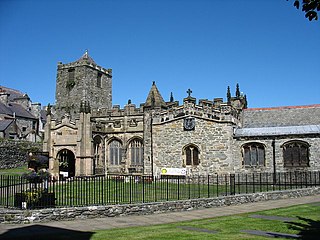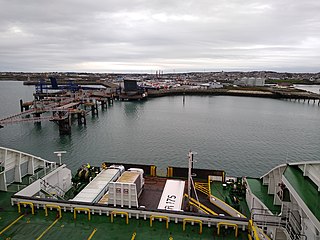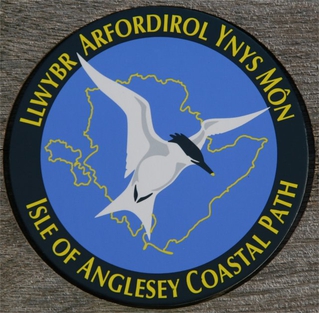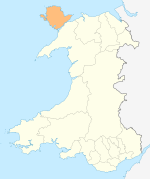
Holyhead is the largest town and a community in the county of Isle of Anglesey, Wales, with a population of 13,659 at the 2011 census.. Holyhead is on Holy Island, bounded by the Irish Sea to the north, and is separated from Anglesey island by the narrow Cymyran Strait and was originally connected to Anglesey via the Four Mile Bridge.

Holy Island is an island on the western side of the larger Isle of Anglesey, Wales, from which it is separated by the Cymyran Strait. It is called "Holy" because of the high concentration of standing stones, burial chambers, and other religious sites on the small island. The alternative English name of the island is Holyhead Island. According to the 2011 UK Census, the population was 13,659, of whom 11,431 (84%) lived in the largest town, Holyhead.

Cledwyn Hughes, Baron Cledwyn of Penrhos, was a Welsh Labour Party politician, usually associated with the moderate wing of the party. He was also regarded, particularly in later years, as a non-political figure of stature in Wales having held posts of importance in bodies such as the University of Wales.

Anglesey Aluminium was a joint venture between Rio Tinto and Kaiser Aluminum. Its aluminium smelter, located on the outskirts of Holyhead, was one of the largest employers in North Wales, with 540 staff members, and began to produce aluminium in 1971. It was built on the Penrhos Estate, 500 acres (200 ha) of which were sold by the Stanley family for the project. Up until its closure it produced up to 142,000 tonnes of aluminium every year and was the biggest single user of electricity in the United Kingdom.

Salt Island is joined to Holy Island, Anglesey, in North Wales. It is a natural provider of shelter for the town's Old Harbour from the Irish Sea and is part of the Port of Holyhead.

Trearddur or Trearddur Bay is a village, seaside resort and community south of Holyhead on the west coast of Holy Island off the north-west coast of Anglesey in Wales. The community includes the small settlement of Penrhosfeilw and the Refail Farm estate.

The Anglesey Coastal Path is a 200-kilometre (124 mi) long-distance footpath around the island of Anglesey in North Wales. The route is part of the Wales Coast Path.

Penrhos Country Park is a country park near Holyhead, on the island of Anglesey in Wales, United Kingdom. The park attracts approximately 100,000 visitors each year. It was opened in 1971 on the former Penrhos estate which was formerly owned by the Stanley family and at the time of opening the Anglesey Aluminium company.

John Thomas Stanley, 1st Baron Stanley of Alderley, known as Sir John Stanley, 7th Baronet, from 1807 to 1839, was a British peer and politician.

The Holyhead Mountain Hut Circles named in Welsh: Tŷ Mawr / Cytiau'r Gwyddelod, literally meaning Big house or "Irishmen's Huts". are the remains of a group of Celtic Iron Age huts near Trearddur on Holy Island, Anglesey, Wales. The site is under the care of Cadw and can be visited all year round. The construction of these huts is very similar to those at Din Lligwy, having thick stone walls.

The Isle of Anglesey is a county off the north-west coast of Wales. It is named after the island of Anglesey, which makes up 94% of its area, but also includes Holy Island and some islets and skerries. The county borders Gwynedd across the Menai Strait to the southeast, and is otherwise surrounded by the Irish Sea. Holyhead is the largest town, and the administrative centre is Llangefni. The county is part of the preserved county of Gwynedd.

Hon. William Owen Stanley was a British Liberal Party politician.

The Big House, also known as Landshipping House, is a historic house on the banks of the River Cleddau in Landshipping, Pembrokeshire, Wales.

Carreglwyd is a Georgian country house, on the northwest of the Isle of Anglesey, about 1 km NW of Llanfaethlu in Wales, at grid reference SH309878.

Trefignath is a Neolithic burial chamber near Trearddur, south of Holyhead on Holy Island, off Anglesey in Wales. In its most complete form it included a large cairn covering three stone tombs, set on a small knoll. It was excavated between 1977 and 1979, revealing several phases of occupation with three separate burial chambers built in succession. It is a scheduled ancient monument, maintained by Cadw.
Sir John Thomas Stanley, 6th Baronet FRSE FSA was an 18/19th century British landowner and amateur scientist.

Ysbyty Penrhos Stanley is a health facility in Holyhead, Anglesey, Wales. It is managed by the Betsi Cadwaladr University Health Board.

Stanley Sailors' Hospital was a health facility in Holyhead, Anglesey, Wales.

Plas Bodewryd is a Grade II* listed privately owned country house in Bodewryd, Anglesey, which was owned by the Wynne family until 1755 then the Lords Stanley of Alderley until the 20th century.




















